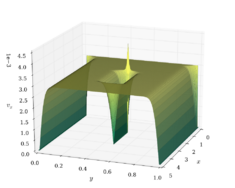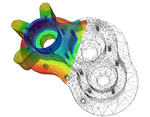Homogeneous differential equation
 From HandWiki - Reading time: 6 min
From HandWiki - Reading time: 6 min
A differential equation can be homogeneous in either of two respects.
A first order differential equation is said to be homogeneous if it may be written
where f and g are homogeneous functions of the same degree of x and y.[1] In this case, the change of variable y = ux leads to an equation of the form
which is easy to solve by integration of the two members.
Otherwise, a differential equation is homogeneous if it is a homogeneous function of the unknown function and its derivatives. In the case of linear differential equations, this means that there are no constant terms. The solutions of any linear ordinary differential equation of any order may be deduced by integration from the solution of the homogeneous equation obtained by removing the constant term.
History
The term homogeneous was first applied to differential equations by Johann Bernoulli in section 9 of his 1726 article De integraionibus aequationum differentialium (On the integration of differential equations).[2]
Homogeneous first-order differential equations
| Differential equations |
|---|
 |
| Classification |
| Solution |
A first-order ordinary differential equation in the form:
is a homogeneous type if both functions M(x, y) and N(x, y) are homogeneous functions of the same degree n.[3] That is, multiplying each variable by a parameter λ, we find
Thus,
Solution method
In the quotient
That is
Introduce the change of variables y = ux; differentiate using the product rule:
This transforms the original differential equation into the separable form
or
which can now be integrated directly: ln x equals the antiderivative of the right-hand side (see ordinary differential equation).
Special case
A first order differential equation of the form (a, b, c, e, f, g are all constants)
where af ≠ be can be transformed into a homogeneous type by a linear transformation of both variables (α and β are constants):
Homogeneous linear differential equations
A linear differential equation is homogeneous if it is a homogeneous linear equation in the unknown function and its derivatives. It follows that, if φ(x) is a solution, so is cφ(x), for any (non-zero) constant c. In order for this condition to hold, each nonzero term of the linear differential equation must depend on the unknown function or any derivative of it. A linear differential equation that fails this condition is called inhomogeneous.
A linear differential equation can be represented as a linear operator acting on y(x) where x is usually the independent variable and y is the dependent variable. Therefore, the general form of a linear homogeneous differential equation is
where L is a differential operator, a sum of derivatives (defining the "0th derivative" as the original, non-differentiated function), each multiplied by a function fi of x:
where fi may be constants, but not all fi may be zero.
For example, the following linear differential equation is homogeneous:
whereas the following two are inhomogeneous:
The existence of a constant term is a sufficient condition for an equation to be inhomogeneous, as in the above example.
See also
Notes
- ↑ Dennis G. Zill (15 March 2012). A First Course in Differential Equations with Modeling Applications. Cengage Learning. ISBN 978-1-285-40110-2. https://books.google.com/books?id=pasKAAAAQBAJ&q=homogeneous.
- ↑ "De integraionibus aequationum differentialium". Commentarii Academiae Scientiarum Imperialis Petropolitanae 1: 167–184. June 1726. https://archive.org/details/commentariiacade01impe.
- ↑ Ince 1956, p. 18
References
- Boyce, William E.; DiPrima, Richard C. (2012), Elementary differential equations and boundary value problems (10th ed.), Wiley, ISBN 978-0470458310. (This is a good introductory reference on differential equations.)
- Ince, E. L. (1956), Ordinary differential equations, New York: Dover Publications, ISBN 0486603490, https://archive.org/details/ordinarydifferen029666mbp. (This is a classic reference on ODEs, first published in 1926.)
- Andrei D. Polyanin; Valentin F. Zaitsev (15 November 2017). Handbook of Ordinary Differential Equations: Exact Solutions, Methods, and Problems. CRC Press. ISBN 978-1-4665-6940-9. https://books.google.com/books?id=L3JQDwAAQBAJ&q=homogeneous.
- Matthew R. Boelkins; Jack L. Goldberg; Merle C. Potter (5 November 2009). Differential Equations with Linear Algebra. Oxford University Press. pp. 274–. ISBN 978-0-19-973666-9. https://books.google.com/books?id=s1-mZMg5fLgC&q=homogeneous&pg=PA274.
External links
- Homogeneous differential equations at MathWorld
- Wikibooks: Ordinary Differential Equations/Substitution 1
 |
21 views | Status: cached on August 06 2024 20:11:25
↧ Download this article as ZWI file
 KSF
KSF
